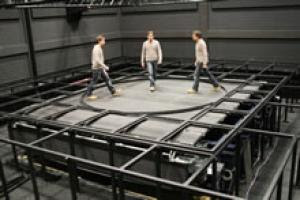In April 2008, European researchers will demonstrate that walking through virtual environments is set to be a reality. To make virtual walking a reality, the CyberWalk researchers had to address five key issues: providing a surface to walk on, controlling the surface in a way that minimised forces on the user, developing a non-intrusive tracking system, displaying a high-quality visualisation, and ensuring a natural human perception of the virtual environment. This month, at a special workshop in Tuebingen, Germany, the EU-funded researchers will demonstrate their treadmill allowing unconstrained walking in all directions (omni-directional) through large-scale virtual environments. Several attempts have been made to develop omni-directional treadmills, with Japanese researchers producing prototypes, and a group in the USA developing a smaller treadmill for military use. Neither allow for truly natural walking and immersion in a virtual environment. The treadmill, or CyberCarpet, incorporates several new mechanical solutions, which ensure smooth and safe operation. The key to the CyberCarpet is a platform with a big chain drive. The chain elements are made of conventional treadmills. The chain moves in one direction whereas the movement direction of the belts is orthogonal to that. Summing the two directions of the chain and the belts provides the omni-directional actuation principle and so the treadmill motion opposing the motion of the walker can be in any direction.
 To track the walker, CyberCarpet wanted to dispense with the Hollywood-style suits covered in reflective marker balls. Its unique system uses cameras to track the position and posture of the individual. This helps control the velocity of the treadmill and interactions with the virtual environment. The possibility of walking through large virtual environments has already received a lot of attention and captured the public’s attention. One project partner, the Swiss Federal Institute of Technology (ETHZ) developed the CityEngine, developed a software package for quickly creating large-scale virtual environments in particular cities, in various degrees of detail. Combining the CityEngine with CyberWalk will allow people to go beyond strolling through the streets of ancient Pompeii and Rome. Architects, for example, could transport customers into the future, and allow them to walk through buildings even before they have been built. ETHZ is considering exploiting CityEngine as a tool for the gaming industry. Talks with some game production houses are already underway. Beyond the obvious use in entertainment, the achievements of the CyberWalk project could extend to training for firemen in dangerous scenarios, while keeping them well out of harm’s way. It could also help with medical rehabilitation for people after a stroke, people with Parkinson’s disease, or to help them overcome phobias. The developments have also created exciting new academic possibilities for research into behavioural science and the biomechanics of human locomotion. But the showcase demonstration is pure escapism, bringing Pompeii to life again after nearly two millennia.
To track the walker, CyberCarpet wanted to dispense with the Hollywood-style suits covered in reflective marker balls. Its unique system uses cameras to track the position and posture of the individual. This helps control the velocity of the treadmill and interactions with the virtual environment. The possibility of walking through large virtual environments has already received a lot of attention and captured the public’s attention. One project partner, the Swiss Federal Institute of Technology (ETHZ) developed the CityEngine, developed a software package for quickly creating large-scale virtual environments in particular cities, in various degrees of detail. Combining the CityEngine with CyberWalk will allow people to go beyond strolling through the streets of ancient Pompeii and Rome. Architects, for example, could transport customers into the future, and allow them to walk through buildings even before they have been built. ETHZ is considering exploiting CityEngine as a tool for the gaming industry. Talks with some game production houses are already underway. Beyond the obvious use in entertainment, the achievements of the CyberWalk project could extend to training for firemen in dangerous scenarios, while keeping them well out of harm’s way. It could also help with medical rehabilitation for people after a stroke, people with Parkinson’s disease, or to help them overcome phobias. The developments have also created exciting new academic possibilities for research into behavioural science and the biomechanics of human locomotion. But the showcase demonstration is pure escapism, bringing Pompeii to life again after nearly two millennia.More information:
http://www.sciencedaily.com/releases/2008/04/080412174455.htm